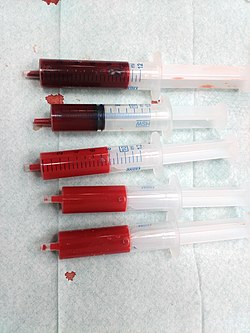| Blood | |
|---|---|
 Venous (darker) and arterial (brighter) blood | |
| Identifiers | |
| MeSH | D001769 |
| TA98 | A12.0.00.009 |
| TA2 | 3892 |
| FMA | 9670 |
| Anatomical terminology | |
Blood is a body fluid in the circulatory system of humans and other vertebrates that delivers necessary substances such as nutrients and oxygen to the cells, and transports metabolic waste products away from those same cells.[1]
Blood is composed of blood cells suspended in blood plasma. Plasma, which constitutes 55% of blood fluid, is mostly water (92% by volume),[2] and contains proteins, glucose, mineral ions, and hormones. The blood cells are mainly red blood cells (erythrocytes), white blood cells (leukocytes), and (in mammals) platelets (thrombocytes).[3] The most abundant cells are red blood cells.[4] These contain hemoglobin, which facilitates oxygen transport by reversibly binding to it, increasing its solubility.[5] Jawed vertebrates have an adaptive immune system, based largely on white blood cells. White blood cells help to resist infections and parasites. Platelets are important in the clotting of blood.
Blood is circulated around the body through blood vessels by the pumping action of the heart. In animals with lungs, arterial blood carries oxygen from inhaled air to the tissues of the body, and venous blood carries carbon dioxide, a waste product of metabolism produced by cells, from the tissues to the lungs to be exhaled. Blood is bright red when its hemoglobin is oxygenated and dark red when it is deoxygenated.[6][7]
Medical terms related to blood often begin with hemo-, hemato-, haemo- or haemato- from the Greek word αἷμα (haima) for "blood". In terms of anatomy and histology, blood is considered a specialized form of connective tissue,[8] given its origin in the bones and the presence of potential molecular fibers in the form of fibrinogen.[citation needed]
- ^ "Definition of BLOOD". Merriam-Webster. Archived from the original on 23 March 2017. Retrieved 4 March 2017.
- ^ The Franklin Institute Inc. "Blood – The Human Heart". Archived from the original on 5 March 2009. Retrieved 19 March 2009.
- ^ "Definition of red blood cell". National Cancer Institute. 2 February 2011. Archived from the original on 25 April 2022. Retrieved 28 April 2022.
- ^ Aryal, Sagar (3 January 2017). "Blood cells and its types with functions". Microbiology Info.com. Archived from the original on 12 April 2022. Retrieved 28 April 2022.
- ^ "Low Hemoglobin: Causes & Symptoms". Cleveland Clinic. Archived from the original on 28 April 2022. Retrieved 28 April 2022.
- ^ Séguin, Chantal (8 January 2022). "Did You Know That Not All Blood is Red? • The Blood Project". The Blood Project. Archived from the original on 2 July 2022. Retrieved 2 July 2022.
- ^ "Is blood blue? 7 facts about blood". www.medicalnewstoday.com. 10 April 2018. Archived from the original on 29 March 2023. Retrieved 29 March 2023.
- ^ Krause, William J. (2005). Krause's Essential Human Histology for Medical Students (3rd ed.). Universal-Publishers. p. 67. ISBN 978-1-58112-468-2. Archived from the original on 26 April 2023. Retrieved 21 June 2022.